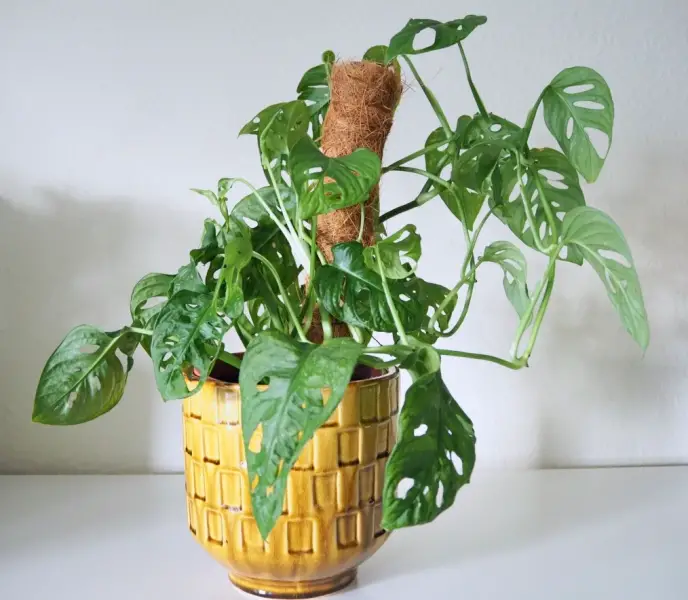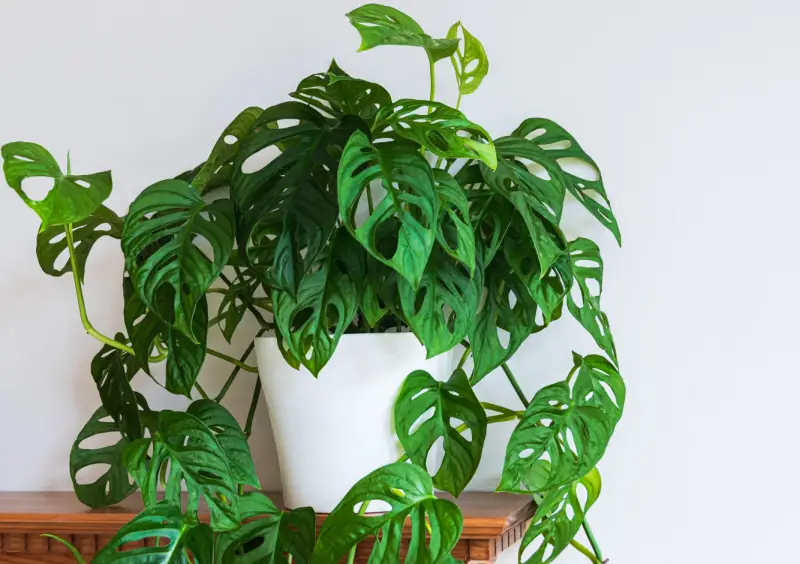If you’re looking to cultivate a lush, eye-catching plant that adds a touch of tropical flair to your space, Monstera adansonii, commonly known as the Swiss cheese plant, is an excellent choice. Known for its distinctive foliage with dramatic perforations, this plant not only enhances indoor decor but also offers a rewarding gardening experience.
In this comprehensive care and growing guide, we’ll delve into every aspect of maintaining a healthy Monstera adansonii, from ideal light conditions and soil requirements to watering practices and pest management.
Whether you’re a seasoned plant enthusiast or a beginner, this guide will provide you with the detailed information needed to ensure your Swiss cheese plant thrives and continues to be a stunning feature in your home.
Monstera Adansonii Overview

Monstera adansonii, commonly known as the Swiss cheese plant or Swiss cheese vine, is a popular perennial houseplant known for its distinctive, perforated leaves. Belonging to the Araceae family, this plant is native to Central and South America, where it thrives in warm, humid environments. When grown outdoors, Monstera adansonii can reach an impressive height of 10 to 13 feet, while indoor specimens typically range between 3 to 8 feet tall and 1 to 3 feet wide.
This plant prefers partial sunlight, making it ideal for indoor spaces with indirect light. It flourishes in moist, well-drained soil, with a preference for acidic to neutral pH levels. While the Swiss cheese plant is known for its lush foliage, it rarely blooms indoors. However, when it does bloom in its natural habitat, it produces white flowers in the spring.
Monstera adansonii is suitable for growing in USDA hardiness zones 10 to 12, making it a perfect choice for warm, tropical climates. Despite its beauty, it’s important to note that this plant is toxic to pets, so care should be taken if you have animals in your home. With its unique leaf patterns and manageable care requirements, the Swiss cheese plant remains a favorite among plant enthusiasts, adding a touch of tropical charm to any indoor or outdoor garden.
Monstera adansonii Care
To care for your Monstera adansonii, start by ensuring it is planted in well-draining soil to prevent root rot. Water the plant regularly, allowing the soil to dry out slightly between waterings before thoroughly moistening it again. Adding a stake or moss pole to the center of the pot will provide the Swiss cheese plant with the support it needs to climb, mimicking its natural environment. Once the plant is well established, feed it with a balanced houseplant fertilizer to encourage healthy growth. Lightly prune your Monstera adansonii as needed to maintain its shape and manage its size.
Light
Monstera adansonii thrives best in bright, indirect light, making it an ideal plant for indoor environments with filtered sunlight. Direct sunlight can be too harsh for its delicate leaves, leading to scorching or browning. To prevent this, it’s important to place your Monstera adansonii in a spot where it receives ample light without being exposed to the sun’s intense rays. If direct sunlight is unavoidable, limit its exposure to just two or three hours of the gentler morning sun, which is less likely to cause damage.
Soil
Monstera adansonii, or Swiss cheese plant, thrives in a peat-based potting mix that provides the ideal balance of moisture retention and drainage. This type of soil helps trap enough moisture to keep the plant hydrated without causing it to become waterlogged, which can lead to root rot. To promote strong and healthy growth, aim for a soil pH between 5.5 and 7, which offers the slightly acidic to neutral environment that the plant prefers.
Water
To properly water your Monstera adansonii, allow the top inch of soil to dry out before watering again. The soil should remain consistently moist but never soaked, as overly wet conditions can lead to root rot. Using a well-draining terracotta container is ideal, as it helps regulate moisture levels by allowing excess water to evaporate, ensuring that your Swiss cheese plant receives just the right amount of hydration. This careful balance will keep your plant healthy and thriving.
Temperature and Humidity
Monstera adansonii flourishes in warm temperatures ranging from 60°F to 85°F and thrives in high humidity levels above 50%. A warm, well-lit bathroom, free of drafts, provides an ideal environment for this plant, as it naturally mimics the humid conditions of its native habitat. If the humidity in your home is lower than desired, you can increase it by placing the plant on a pebble tray filled with water or using a humidifier in its space. Maintaining the right temperature and humidity levels will help your Swiss cheese plant grow vigorously and keep its foliage lush.
Fertilizer
To support the growth of your Monstera adansonii, apply a balanced houseplant fertilizer with an N-P-K ratio of 5-2-3 once a month during the growing season, which runs from May to September. However, after repotting, wait until the plant is well established before beginning fertilization. Fresh potting mix usually contains slow-release fertilizer, and the plant’s sensitive roots need time to settle and recover from the stress of being moved. You can make sure your Swiss cheese plant gets the nutrients it needs to flourish without overfeeding its roots by following this fertilization schedule.
Support and Staking
Monstera adansonii, known for its vigorous climbing habit, naturally develops aerial roots that grow downward from the stem, anchoring the plant to the ground or any nearby structure. In its native environment, these roots help the plant climb trees or woody vines, allowing it to reach sunlight and thrive in dense forests.
When grown indoors, providing proper support is essential to keep the plant contained and promote healthy vertical growth. The simplest way to offer this support is by inserting a wooden, metal, or plastic stake into the center of the pot. As the plant matures, its aerial roots will latch onto the stake, mimicking its natural climbing behavior. This not only keeps the plant upright and well-supported but also enhances its overall appearance, making it a striking addition to any indoor space.
Pruning
Monstera adansonii, being a vigorous climber, may require pruning if it starts to outgrow its space. The ideal time to prune a Swiss cheese plant is in the spring, and any cuttings can be propagated to grow new plants.
Use sterile pruning shears to trim back the stems, reducing them by no more than 25 percent. Make your cuts just above a leaf node to ensure the stem remains healthy and intact. Additionally, remove any dead or damaged leaves as needed to keep the plant looking its best and to promote healthy growth.
Common Pests & Plant Diseases
Monstera adansonii plant is susceptible to several common houseplant pests, including mealybugs, spider mites, scales, and whiteflies. These pests can cause various issues, such as wilting, leaf damage, and a general decline in plant health. Fortunately, they are rarely fatal and can be effectively managed using nontoxic insecticides or neem oil. Regularly inspecting your plant and treating any infestations promptly will help maintain its health and vigor.
In addition to pests, the Swiss cheese plant can be affected by a range of plant diseases. Common issues include root rot, which often results from overwatering and poor drainage; rust, which causes orange or brown spots on the leaves; powdery mildew, characterized by a white, powdery substance on the foliage; and blight, which leads to dark, sunken lesions on leaves and stems. Keeping an eye out for these diseases and addressing them early will help prevent serious damage and keep your Swiss cheese plant thriving.
Types of Monstera adansonii Plant
Monstera deliciosa
Monstera deliciosa is a well-known relative of the Swiss cheese plant, recognized for its large, impressive leaves that are significantly bigger than those of Monstera adansonii. The leaves of Monstera deliciosa are deeply lobed and perforated, providing a dramatic and tropical appearance. This species is often admired for its ability to grow into a large, expansive plant, making it a popular choice for adding a bold, lush touch to indoor spaces.
Monstera borsigiana
Monstera borsigiana is a smaller, faster-growing variant of Monstera deliciosa. It shares many characteristics with Monstera deliciosa but remains more compact, making it suitable for smaller spaces. The most popular variety within this species is Monstera albo, known for its striking white and green variegation. This plant’s vibrant coloration and faster growth rate make it a favorite among plant enthusiasts.
Monstera obliqua
Monstera obliqua is a rare species that bears a close resemblance to Monstera adansonii but features thinner leaves with more pronounced holes. Its unique leaf structure and rarity make it a highly sought-after plant for collectors. The increased fenestration and delicate appearance of Monstera obliqua distinguish it from its more common relatives.
Monstera dubia
Monstera dubia is known for its beautiful, variegated leaves that add a touch of elegance to any collection. This cultivar is appreciated for its distinct leaf pattern, which features contrasting shades of green and cream. Its attractive foliage makes it a standout plant in both home and garden settings.
Monstera siltepecana
Also referred to as ‘El Salvador,’ Monstera siltepecana is recognized for its lance-shaped leaves with silvery variegation. The plant’s unique leaf shape and coloration provide a visually appealing contrast, enhancing its decorative appeal. Its striking appearance makes it a popular choice for adding variety to a Monstera collection.
Monstera standleyana
Monstera standleyana, commonly known as Monstera standleyana albo or ‘Albo Variegata,’ features long, slender leaves with dramatic dark green and creamy white variegation. This plant’s distinctive coloring and elongated leaf shape contribute to its striking visual impact, making it a prized addition for enthusiasts seeking a plant with a dramatic appearance.
Monstera pinnatipartita
Monstera pinnatipartita is notable for its fast growth and thick, textured leaves. As the leaves mature, they develop stunning fenestration, adding to the plant’s dramatic and lush appearance. Its vigorous growth and impressive leaf structure make Monstera pinnatipartita a popular choice for those looking to grow a striking and robust Monstera variety.
Propagating Monstera adansonii Plant

The easiest method to propagate Monstera adansonii, or the Swiss cheese plant, is through stem cuttings. This technique is both cost-effective and efficient, allowing you to utilize stems removed during pruning to grow new plants. The optimal time for propagation is in the spring. Follow these steps for successful propagation:
- Cutting Preparation: Trim a 4- to 6-inch piece of stem, ensuring you cut just after a leaf node to keep the node intact. Remove any leaves from the bottom third to half of the cutting to prevent them from rotting in the soil.
- Rooting Hormone: Apply a rooting hormone to the cut end of the stem. This encourages the development of roots and helps the cutting establish itself more quickly.
- Planting: Place the prepared cutting in a small container filled with moistened soilless potting mix. Ensure the container has drainage holes to prevent waterlogging. Position the container in a warm location with bright, indirect light to promote healthy root growth.
- Care: Keep the growing medium lightly moist but not soggy. Over the course of a few months, the cutting should develop well-formed roots. Once the roots are established and the plant shows signs of healthy growth, you can transfer it to a larger pot to continue its development.
Potting and Repotting Monstera adansonii Plant
Best Kind of Pot
For Monstera adansonii, any container with drainage holes is suitable, as it helps prevent waterlogging and root rot. These plants also look particularly attractive in hanging baskets, where their trailing vines can be displayed to full effect. When potting a nursery plant, choose a container that is just slightly larger than the plant’s root ball. Ensure the plant is positioned at the same depth it was in its nursery container, and use a peat-based potting mix to provide the necessary aeration and moisture retention.
How Soon Should You Repot?
Repotting your Swiss cheese plant every two years is recommended to accommodate its growth and refresh the potting mix. Signs that it’s time to repot include roots visibly protruding through the drainage holes or emerging above the soil line. Additionally, if you notice that the soil dries out unusually quickly, it may indicate that the plant has outgrown its current container. Spring is the ideal time for potting and repotting, as it aligns with the plant’s active growing season, promoting a smoother transition and healthy growth.
Common Problems with the Monstera adansonii Plant
Leaves are turning yellow.
If the leaves of your Swiss cheese plant are turning yellow, it is often due to overwatering. To prevent this, ensure the plant is not sitting in soggy soil and allow the top inch or so of soil to dry out between waterings. Proper drainage is crucial, so make sure your pot has adequate drainage holes to avoid excess moisture accumulation.
Leaves Wrinkled or Curling
Wrinkled or curling leaves can indicate that the soil is too dry or that the plant is not receiving enough water. Check that your potting soil is well-draining and water the plant thoroughly when the top one to two inches of soil become dry. Water until you see it beginning to run out of the drainage holes to ensure the entire root system is adequately hydrated.
Leaves Turning Black
Black marks on the leaves are often a result of leaf burn from too much direct sunlight. Monitor your plant’s exposure to sunlight throughout the day and protect it from prolonged direct sun, especially strong afternoon rays. Position your plant in a location where it receives bright but indirect light to prevent sun damage.
Leaves Drooping
Drooping leaves can be a sign of either overwatering or underwatering. To address this issue, water your plant when the top two inches of soil are dry, and ensure you water thoroughly until the soil is moist and water begins to exit through the drainage holes. Adjust watering practices as needed based on the plant’s response.
Leaves Falling Off or Not Putting on Size
If the leaves of your Swiss cheese plant are dropping off or not growing to their usual size, it may be due to insufficient light exposure. Monstera adansonii prefers bright but indirect light. If you cannot provide indirect light, bright morning sunlight is better than intense afternoon sunlight. Adjust the plant’s placement to optimize light conditions.
Leaves are not splitting
The distinctive fenestration, or leaf splitting, of Monstera adansonii can be diminished if the plant is not receiving enough light. Increase light exposure gradually to encourage the development of fenestrated leaves without overwhelming the plant with too much direct light all at once. Proper lighting will help the plant achieve its characteristic look.






